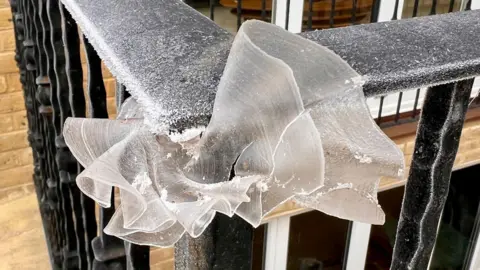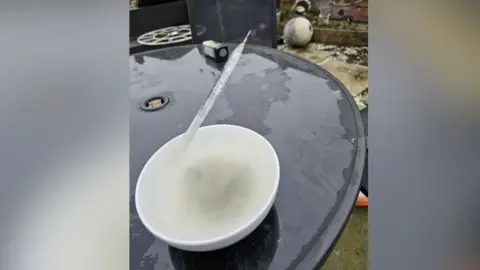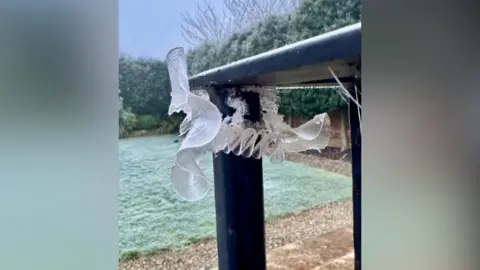Ice spike and ribbon ice appear on frosty weekend
 Victoria Harding-Saunders
Victoria Harding-SaundersUnusual ice formations were captured by Oxfordshire and Berkshire residents during a frosty weekend which also saw impromptu ice skating.
A so-called ice spike and ice flower were spotted outside two houses while frozen surface water at on Oxford's Port Meadow allowed people to skate.
The ice formed after the meadow flooded and then froze, resulting in shallow ice with no deep water underneath, unlike when rivers and lakes freeze over.
The lowest temperature recorded in Oxfordshire on 11 January was -9.5 C (14.9F) in Benson.
 Eugene Kirk
Eugene KirkEugene Kirk found an ice spike shooting out of a bowl in his garden in Newbury.
He said it could have been there for several weeks as he had tried to grow runner beans in a bowl he had left outside.
"Then over time with the rain, the bowl filled up with water.
"I went away for the New Year and when I came back, I was walking up the garden, looked down and saw this spike shooting out of the bowl.
"I couldn't understand what it was," he said.
Mr Kirk said the formation was about 5 inches (12.7cm).
He said he had received different comments after posting a picture of it online.
"No one really knew what it was.
"One tried to explain it, someone else thought it was a spike from a root which got blown into the water and got stuck in there."
Mr Kirk said the spike had since melted.
Prof Richard Katz from University of Oxford's Department of Earth Sciences said ice spikes formed when there was "a small hole in a surface layer of ice, on top of a container of water".
"The water pushed through the hole, freezes at the rim of the hole and builds up an ice spike.
"At the centre of the spike is a tube through which liquid water is pushed out to freeze at the moving rim."
Victoria Harding-Saunders thought she had noticed "a frozen leaf" stuck on an iron railing in her back garden on Oxford's Woodstock Road on Saturday morning.
"A couple of hours later, I noticed that it got bigger, so went out to check it with my other half.
"We both saw what looked like a beautiful flower but it was quite an incredible ice formation."
She said it continued to grow over several hours.
"It had spiralled underneath the railing.
"I'd done a bit of research on it and we haven't been able to find a huge amount of other photos."
Ms Harding-Saunders shared pictures of the formation with family and on Facebook.
"People said they have never seen anything like it before.
"Sadly, as the evening wore on, fragments started dropping off because the temperature probably rose a little bit and then in the morning, it was just a few shards on the ground."
Michael Grae Worster, professor of fluid dynamics at Cambridge University said he had "mostly studied frost flowers that form on sea ice".
"Those form by a process of sublimation from a background ice surface and condensation of ice directly from the cold vapour.
"I think that the term frost 'flower' relates to the shape taken by the ice rather than there being any botanical connection."
He said the "ribbon ice" probably formed from "water trapped in the hollow railing which wants to expand as it cools and freezes".
"It is possible that ribbon ice forms in a similar way to needle ice which is a rather more involved story involving the fact that ice is repelled away from soil grains (silica).
"It is this process (not expansion) that causes potholes to form in our roads."
 Victoria Harding-Saunders
Victoria Harding-SaundersYou can follow BBC Oxfordshire on Facebook, X (Twitter), or Instagram.
